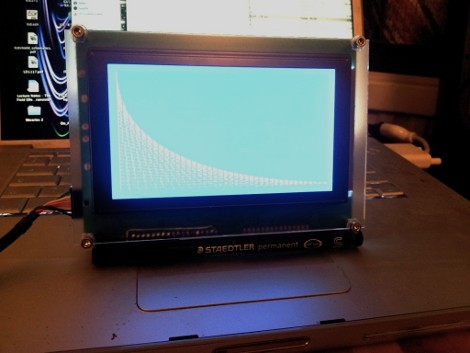
[Tom Fleet] spent the dreary weekend inside learning how to drive this T6963C based graphic LCD controller. Although this is his first time venturing away from HD44780 character displays, the availability of an Arduino library helped him go from being a newbie to coding his own animated graphics.
The hardware setup is straight-forward. The screen has a 20-pin connector and operates at 5V. We don’t see it on his protoboard, but usually these displays also need a potentiometer which serves as a voltage divider for the screen contrast. The data and control pins eat up most of the available I/O on the ATmega328 chip he used, but the I2C and SPI pins are still open and he plans a future project to make this a wireless display for his PC using one of those protocols.
As for fonts and animation, [Tom] links to several tools which will come in handy. There’s a font program that will convert Windows system fonts into a C file for use on the Arduino. The animations start with a 1:1 ratio animated graphic drawn with his favorite image editing software. He then converts those to monochrome bmp files and used bmp2c to convert each frame to a C array. After the break there’s a seven second example that would work well as a boot screen for his project.














If you happen to be drawing in The GIMP, it can save as .c and/or .h files directly. I’ve used that feature with good success in the past
Now that’s interesting, I will be giving that a look. Cheers!
Tom
I really do wish there were cheap, easily obtainable graphics LCDs around. The only ones I ever see are those hideous Nokia clones, and even getting those for a decent price to Australia is difficult.
Surely there is the demand for a cheap, good quality ~128x~128 lcd?
What’s wrong with the Nokia displays? They’re full color, 128×128, and use a fairly simple SPI protocol that only needs a few micro pins. I find them very useful for LCD projects as they’re pretty cheap and full color.
Australia is one stone throw away from china, and knockoff cellphone lcds are almost free (including shipping!) in China, what are you complaining about?
The baby brother of the display I’ve written about here is pin and code compatiable (save for some pixel count definitions), but 128 * 64 pixels. I don’t know what you’re defining cheap as, but it’s £15.30 in single volume quantities from one of our suppliers…
I suppose I’m a bit biased, the last display I worked on was a SPI protocol VFD with the same 128 * 64 pixel count, but at 10 times the cost (~£148)!
I’ve found a display like this at junkjard a couple of weeks ago. Got it for about 2$, and I used the same library like you :D
However I cheated for my negative power supply, I just used 3*9volt batteries and a potentiometer (9v for the arduino, and -18 to the display):P